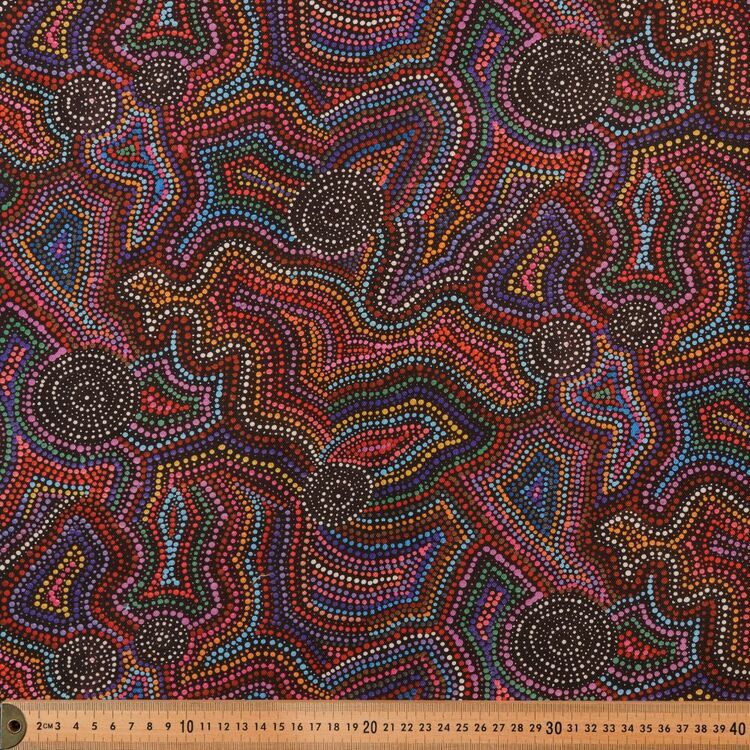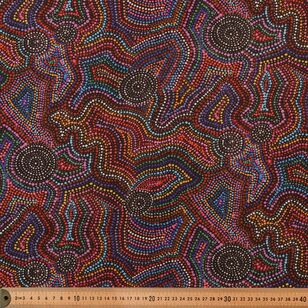 | ||
| Your browser is not supported. | ||
|
Please browse our site using any of the following options:
| ||
Warlukurlangu Desert Truffle Dreaming Multipurpose Cotton Fabric Multicoloured 150 cm
PRODUCT OVERVIEW
Create delightful textile projects with the Warlukurlangu Desert Truffle Dreaming Multipurpose Cotton Fabric. This fabric includes authentic hand painted Indigenous Australian art created by artist Tina Napangardi Martin and has been printed onto a 100% cotton canvas base. This sturdy and versatile fabric may be used for DIY furnishing projects, tote bags, aprons and more. Specific details of the story and iconography of this artwork are highlighted below:
This 'jintiparnta Jukurrpa' (desert truffle [Elderia arenivaga] Dreaming) comes from Mina Mina. Mina Mina is an extremely important ceremonial site for Napangardi and Napanangka women that is located approximately 600kms west of Yuendumu, just east of Lake Mackay and the WA border. The area has a 'marluri' (salt lake or claypan) that is usually dry, without water. There are also a number of 'mulju' (soakages), sandhills, and a large stand of 'kurrkara' (desert oaks [Allocasuarina decaisneana]). The Mina Mina Jukurrpa is an important source of Warlpiri ritual knowledge and social organization, particularly relating to the different roles performed by men and women. The 'kirda' (owners) of this Jukurrpa are Napangardi/Napanangka women and Japangardi/Japanangka men. There are a number of different Jukurrpa associated with Mina Mina - artists usually choose to depict one particular Jukurrpa in their paintings. In addition to 'jintiparnta' (desert truffle), these can include 'karnta' (women), 'karlangu' (digging sticks), 'majardi' (hairstring skirts/tassels), 'ngalyipi' (snakevine [Tinospora smilacina]), and 'kurrkara' (desert oak [Allocasuarina decaisneana]). The Mina Mina Jukurrpa tells the story of a group of ancestral 'karnta' (women) who traveled from west to east. In the Dreamtime, these ancestral women danced at Mina Mina and 'karlangu' (digging sticks) rose up out of the ground. They collected these digging sticks and started travelling to the east. They carried their digging sticks over their shoulders and they were adorned with 'majardi' (hairstring belts), white feathers, and necklaces made from 'yinirnti' (bean tree [Erythrina vespertilio]) seeds. They continuously anointed themselves with 'minyira' (shiny fat) to increase their ritual powers as they went along. As the women travelled, they were followed by a 'yinkardakurdaku' (spotted nightjar [Eurostopodus argus]) from the Jakamarra subsection. The bird would call out and then hide in the bushes behind them as they travelled.
When the women danced at Mina Mina, they created a large dust cloud that swept up the 'walyankarna' (snake ancestors). The 'walyankarna' had previously transformed themselves from witchetty grubs into snakes at Kunajarrayi (Mount Nicker, 200km southwest of Yuendumu), and they had stopped at Mina Mina to watch the women dance. This dust cloud blew the 'walyankarna' further north to Yaturluyaturlu (near the Granites gold mine). In this way, the 'karnta Jukurrpa' (women's Dreaming) and 'ngarlkirdi Jukurrpa' (witchetty grub Dreaming) intersect. This allowed the ancestral women to observe the witchetty grubs and learn how to best locate and cook them, which are skills that Warlpiri women still use today. The women went east from Mina Mina, dancing, digging for bush tucker, and creating many places as they went. As they went east, they passed through Kimayi (a stand of 'kurrkara' (desert oak)). They passed through sandhill country where the 'yarla' (bush potato or 'big yam' [Ipomea costata]) ancestors from Yumurrpa and the 'ngarlajiyi' (pencil yam or 'small yam' [Vigna lanceolata]) ancestors from Yumurrpa were engaged in a huge ba??le over women.
This ba??le is also a very important Warlpiri Jukurrpa narrative. The women went on to Janyinki and stopped at Wakakurrku (Mala Bore), where they stuck their digging sticks in the ground. These digging sticks turned into mulga trees, which still grow at Wakakurrku today. The women then went on to Lungkardajarra (Rich Bore), where they looked back towards their country in the west and started to feel homesick for what they'd le?? behind. The women split up at Lungkardajarra. Some of them travelled eastwards to Yarungkanyi (Mount Doreen), and kept going east. They passed through Coniston in Anmatyerre country, and then went on to Alcoota and Aileron and beyond. The other group of women travelled travelled northwards from Lungkardajarra to Karntakurlangu. These women stopped at Karntakurlangu (an area that literally means 'belonging to women') to dig for 'wardapi' (sand monitor/goanna [Varanus gouldii]) and 'jintiparnta' (desert truffle). 'Jintiparnta' appears in the sandhills a??er the winter rains. The growing fungus forces the earth above it to crack, exposing it. Women dig it out of the ground and squeeze out the liquid inside to drink before cooking it in hot ashes. After stopping to collect the 'jintiparnta' at Karntakurlangu, the women kept traveling further north. However, both groups of women eventually got so homesick for their desert oak country in the west that they went all the way back to Mina Mina, where they stayed for good.
The Mina Mina Jukurrpa (of which this 'jintiparnta' Jukurrpa is a part) contains important information about the different roles that men and women play in Warlpiri culture, particularly in the context of ritual performance. It alludes to an earlier time in which their ritual and social roles were reversed, in which women controlled the sacred objects and weapons that are now exclusively “owned” by men. In contemporary Warlpiri paintings, traditional iconography can be used to represent the Jukurrpa, particular sites, and other elements. In paintings of the 'jintiparnta' Jukurrpa, circles and roundels represent the 'jintiparnta' (desert truffle) that the women collected as they travelled, and straight lines represent their 'karlangu' (digging sticks).
Reg: $30 per metre
$18 per metre






